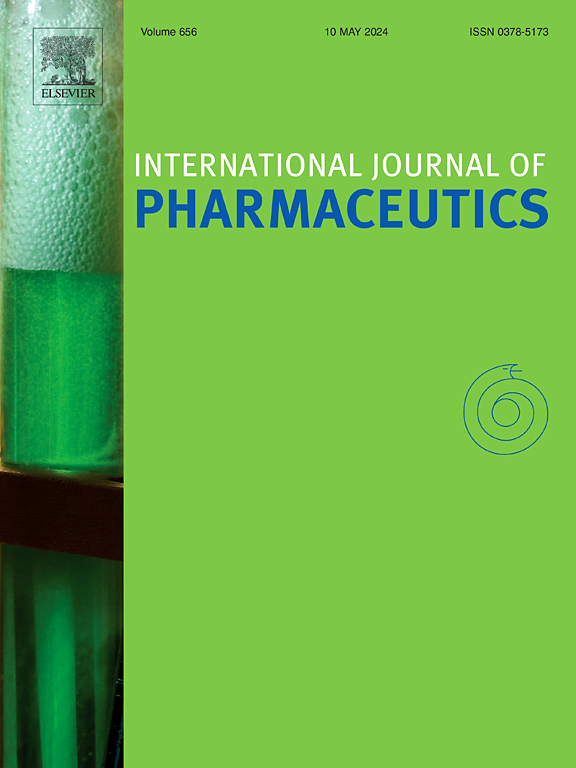Optimized ethylcellulose films incorporating a novel clotrimazole deep eutectic system for enhanced permeation and antifungal activity
IF 5.2
2区 医学
Q1 PHARMACOLOGY & PHARMACY
引用次数: 0
Abstract
Advanced drug delivery systems are engineered by tailoring material interfaces and microstructure to overcome the limitations of conventional formulations, thereby optimizing drug pharmacokinetics and biodistribution. Beyond this, enhancing the efficacy of the loaded drug will be an ideal synergistic outcome. The current work describes developing novel therapeutic deep eutectic solvents (THEDES) of the antifungal drug clotrimazole (CLOT) with capric acid formed at a 1:3 M ratio (C3). The novel THEDES was characterized using FTIR, DSC, and NMR to explore the underlying intermolecular interactions. The antifungal activity of C3 exhibited a 16-fold reduction in the minimum inhibitory concentration (MIC) against C. albicans compared to CLOT. This novel THEDES was subsequently incorporated as a functional excipient into an ethylcellulose (EC) film using a solvent-casting method, serving as both the active ingredient reservoir and a plasticizer. Including C3 in the film maintained the transparency and flexibility of the film, suggesting a plasticizing role. Skin permeation of the optimum film (F4) using Franz diffusion cells fitted with Strat-M® membrane was studied, and the permeation was compared with a commercial CLOT cream. The eutectic film of CLOT demonstrated significantly higher permeation after 24 h compared to the commercial cream. This work presents a green and efficient strategy to enhance the topical delivery of CLOT. By forming a THEDES, we significantly improved drug loading in a hydrophobic EC matrix and achieved a 2.7-fold increase in permeation flux across a skin-mimicking membrane compared to a commercial cream, alongside a 16-fold reduction in the MIC against C. albicans. This approach highlights a promising pathway for developing more effective topical antifungal therapies.

优化的乙基纤维素薄膜包含了一种新型的克霉唑深共晶系统,以增强渗透和抗真菌活性。
先进的给药系统是通过定制材料界面和微观结构来克服传统配方的局限性,从而优化药物的药代动力学和生物分布。除此之外,增强装载药物的功效将是一个理想的协同结果。目前的工作描述了以1:3 M比(C3)形成的癸酸为抗真菌药物克霉唑(CLOT)开发新型治疗性深共晶溶剂(THEDES)。利用FTIR, DSC和NMR对新型THEDES进行了表征,以探索潜在的分子间相互作用。与CLOT相比,C3的抗真菌活性对白色念珠菌的最低抑制浓度(MIC)降低了16倍。这种新型的THEDES随后被作为功能性赋形剂加入到乙基纤维素(EC)薄膜中,使用溶剂铸造法,作为活性成分储存库和增塑剂。在膜中加入C3,保持了膜的透明性和柔韧性,说明有塑化作用。使用配备Strat-M®膜的Franz扩散池研究最佳膜(F4)的皮肤渗透,并与商业CLOT霜的渗透进行比较。24 h后CLOT共晶膜渗透率明显高于商业膏。这项工作提出了一个绿色和有效的策略,以加强局部输送CLOT。通过形成THEDES,我们显著改善了疏水性EC基质中的药物负载,与商业面霜相比,通过皮肤模拟膜的渗透通量增加了2.7倍,同时对白色念珠菌的MIC降低了16倍。这种方法强调了开发更有效的局部抗真菌治疗的有希望的途径。
本文章由计算机程序翻译,如有差异,请以英文原文为准。
求助全文
约1分钟内获得全文
求助全文
来源期刊
CiteScore
10.70
自引率
8.60%
发文量
951
审稿时长
72 days
期刊介绍:
The International Journal of Pharmaceutics is the third most cited journal in the "Pharmacy & Pharmacology" category out of 366 journals, being the true home for pharmaceutical scientists concerned with the physical, chemical and biological properties of devices and delivery systems for drugs, vaccines and biologicals, including their design, manufacture and evaluation. This includes evaluation of the properties of drugs, excipients such as surfactants and polymers and novel materials. The journal has special sections on pharmaceutical nanotechnology and personalized medicines, and publishes research papers, reviews, commentaries and letters to the editor as well as special issues.

 求助内容:
求助内容: 应助结果提醒方式:
应助结果提醒方式:


